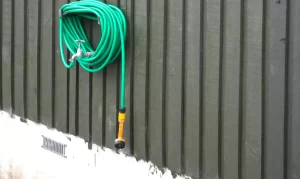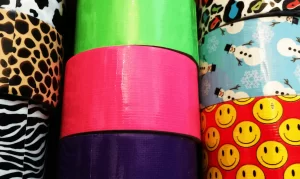How to Fix a Hole in an Expandable Hose? There are many applications where an expandable hose is preferable to a conventional rubber garden hose. They are, however, more susceptible to leaks and breaks than their conventional counterparts. While it may be easier in our consumer culture to simply replace the component, can an expandable hose be repaired? A quick repair is much more appealing to many people because it reduces waste and total expense.
A broken expandable garden hose can be repaired. While a haphazard approach will work in the short term, it will most likely fail once high pressure is forced through the tubing. A permanent solution is to sever the hose and reconnect it with connectors.
Knowing how to fix an expandable hose will help you save time, money, and frustration. Due to the latex material used in its construction, some methods that you might have used for conventional garden hoses may not work with an expandable hose.
Contents
- What Makes an Expandable Hose Different?
- How to Fix a Hole in an Expandable Hose? Repairing with Connectors Is the Best Option
- How to Remove the Outer Layer
- Taking Out the Damaged Inner Hose
- Making the New Connection
- Methods That Won’t Work
- Duct Tape
- Water-resistant Tape
- Leak Sealant
- What Are The Benefits of an Expandable Hose?
- Can You Use A Pressure Washer With An Expandable Hose?
- Final Thoughts: How to Fix a Hole in an Expandable Hose?
What Makes an Expandable Hose Different?
Because of the materials used to produce them, expandable hoses are difficult to repair.
- Expandable hoses are made of latex, as opposed to regular tubes, which are often made of rubber. The material’s “stretchiness” is what causes the hose to elongate up to three times its original length when pressurized. This is due to the latex’s chemical composition.
- The majority of latex in expandable hoses is made from synthetic and natural latex and contains between 55 and 65 percent water. During the manufacturing process, Sulfur, carbon black, and oil are added to strengthen the products. Several layers of latex (typically 2-4) are used to reinforce the hose and provide fail-safes if one layer becomes weakened.
- When under pressure, the latex material expands and becomes thinner. If you’ve ever made a turkey balloon out of a latex glove, you might have found that the material thinned out to the point that it was nearly transparent. This is what is going on inside your expandable hose, except with water instead of air as the pressurizer. It is because of these properties that most repair methods are faulty and likely to cause additional harm.
By knowing the substance inside your hose, you can far more easily troubleshoot repair solutions with materials on hand.
How to Fix a Hole in an Expandable Hose? Repairing with Connectors Is the Best Option
There are two ways for an expandable hose to leak: either there is a hole in the inner latex tube, or the connector has detached from the hose at one end. If you fix it the “traditional” way, you will most definitely have continuing problems. This is due to the fact that the repaired latex portion is still fragile and can rupture repeatedly.
In both cases, the best approach is to completely remove the damaged portion of the hose and repair it in a three-step procedure.
There are two layers of expandable hoses:
- The inner tube is made of latex and stretches when under pressure.
- The outer tubing is made of nylon cloth and serves to secure the delicate inner hose.
Although the leaks would most likely occur in the inner pipe, you would most likely need to remove the protective outer layer first in order to reach the latex tubing beneath it.
-
How to Remove the Outer Layer
Remove the connectors at either end and roll down the outer layer to gain access to the puncture spot. The nylon cover should have enough slack to allow for this. If not, cut the nylon and stitch it back together after the repair is done.
-
Taking Out the Damaged Inner Hose
There’s nothing complex here. To remove the damaged section of the inner hose, make a clean cut with a knife, pair of garden shears, or a box cutter.
-
Making the New Connection
To make a new link inside the hose, make sure the following are clean:
- First, strip any old tubing (if applicable) and clean the connector of any debris.
- Then, when the hose is pressurized, use barbed connectors so that it expands around the connector. Use expandable tape (Teflon tape or silicon plumbers’ tape) to make a strong seal on both ends before inserting the barb into the tubing. Don’t use too much tape; once or twice around the perimeter should suffice. It will also extend and form a better seal.
Learn more about How to Drain a Hot Tub with a Garden Hose?
By removing the damaged portion of the hose, you are removing the hose’s weakest link. The expanding latex material works well with connectors. That is why this is the safest long-term solution for a leak in an expandable hose.
Methods That Won’t Work
You may be wondering if any methods that work on standard hoses would work on expandable ones. The issue is that due to the expansion of the latex hose material, most sealants and tapes cannot repair a leak in the hose for long. Most sealants will loosen under pressure, or adhesive tapes will come loose by stretching the seal and pressurizing the repair site.
Here are some unsuccessful approaches for repairing non-expandable hoses that you should avoid:
Duct Tape
Although duct tape is a universal remedy for most fast fixes, it will not help you stop your garden hose from leaking. This is due to two factors.
- First and foremost, it is not a waterproof product. As a result, the adhesive glue that makes duct tape so strong can deteriorate as soon as the hose is turned on.
- Second, duct tape has no give, which means it is not flexible. When the inner tubing is pressurized, the latex material may want to stretch. The connection between the tape and the pipe would be placed under additional pressure as a result of this. As a result, the duct tape would easily loosen and fall off.
Water-resistant Tape
It is prudent to choose a water-resistant-based product for your requirements. When the hose is turned on, and water flows past it, the adhesive bond will not deteriorate as easily. However, once the tube is pressurized, this tape still exhibits the same stretch problem. By layering the tape, you can be able to provide yourself with a fast fix to allow you to use the hose at that time. This seal, however, will not last long.
Leak Sealant
Leak sealants come in a variety of varieties, ranging from spray-on materials to silicone-based pastes. These materials can perform better than adhesive tape because many of them contain a compound that allows for some give. As a result, when the hose extends, the sealant does not break immediately. However, there are two major drawbacks to these products:
- For starters, they can take up to 48 hours to dry and stick properly. If you are willing to wait this long to repair your hose, it is much easier to buy barbed connectors and permanently fix them.
- The second problem is that the seal will eventually crack and will not have a long-term solution.
Although the methods mentioned above can be useful in a pinch, none of them are long-term fixes for your expandable hose. If you do use them, keep the water pressure low (do not turn the faucet completely on) to keep the PSI in the tubing to a minimum. As a result, your fast fix will last longer!
Frequently Answered Questions
What Are The Benefits of an Expandable Hose?
Expandable hoses are a game-changer in the garden hose market. They are a lightweight alternative to traditional, bulky garden hoses made of latex with a nylon outer shell. They are usually five times lighter than their rubber counterparts.
Their success stems from the fact that they can be expanded to three times their original length. This is especially helpful for storing and transporting the hose. When the water pressure is withdrawn, the hose contracts and self-empties, making the user’s life much easier. The most important advantage that most people appreciate is that an expandable hose does not tangle, curl, or kink. When opposed to using a traditional rubber garden hose, these features combined make going around the garden to manually water your plants a breeze.
Can You Use A Pressure Washer With An Expandable Hose?
A hose is needed for all pressure washers. Expandable hoses have become more reliable in recent years; early versions were notoriously leaky and didn’t last too long with daily use.
Learn more about How to Increase Water Pressure in Garden Hose?
Despite advancements in reliability, most expandable hoses are incompatible with pressure washers. The high pressure (2000-3000 PSI) will overstretch the latex, causing it to burst. In most households, the water pressure from a faucet is about 40-60 PSI, with a maximum of 80 PSI. Most hoses are not equipped to withstand the high-water pressures produced by a pressure washer. It is recommended that you use a rubber-based hose or an expandable hose that is explicitly rated for a pressure washer if you are using a pressure washer.
Final Thoughts: How to Fix a Hole in an Expandable Hose?
When fixing an expandable hose, you must make a permanent fix – a simple patchwork job will not last long. Many adhesive solutions are inefficient and temporary due to the stretchiness of the latex material in an expandable hose. Instead, excise the area of the tube with the leak and reattach the two pieces of hose with permanent, barbed connectors. As a result, the hole will be repaired, and the tubing will be solid once more.




